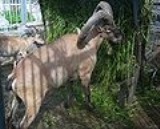
East Caucasian Tur
Encyclopedia
The East Caucasian tur (Capra cylindricornis) is a mountain dwelling goat antelope
found only in the eastern half of the Caucasus Mountains
.
East Caucasian turs stand up to 1 metres (39.4 in) tall at the shoulder and weigh around 60 kilograms (132.3 lb). They have large but narrow bodies and short legs. They generally have a dark chestnut coat in winter
and a lighter chestnut coat in summer
. Males have slightly lyre shaped horns which reach around 90 centimetres (35.4 in) in length while in females they are much smaller (30 centimetres (11.8 in) maximum).
East Caucasian turs live in rough mountainous terrain between 800 and 4000 m (2,624.7 and 13,123.4 ft) above sea level where they eat mainly grass
es and leaves
and are preyed upon by wolves and lynx
es. Females live in herds of around ten individuals, while males are solitary.
period of only around 150 days (about six months). Young turs are extremely agile, being able to scamper about steep slopes after only a day of life. They generally start sampling grasses after on months, but continue to suckle for 2-4 months.
There is a seasonal migration covering a vertical distance of 1500 metre, with an upward thrust in May and a retreat downwards in October. The solitary adult males generally inhabit higher altitudes than groups of females and their young, descending to join them in the breeding season. During this time, vigorous competitions arise as they vie for mating
rights. In protected areas, the density of animals varies between 5/km² and 16/km².
Goat antelope
A goat-antelope or caprid is any of the species of mostly medium-sized bovids that make up the subfamily Caprinae , part of the Bovidae family of ruminants...
found only in the eastern half of the Caucasus Mountains
Caucasus Mountains
The Caucasus Mountains is a mountain system in Eurasia between the Black Sea and the Caspian Sea in the Caucasus region .The Caucasus Mountains includes:* the Greater Caucasus Mountain Range and* the Lesser Caucasus Mountains....
.
East Caucasian turs stand up to 1 metres (39.4 in) tall at the shoulder and weigh around 60 kilograms (132.3 lb). They have large but narrow bodies and short legs. They generally have a dark chestnut coat in winter
Winter
Winter is the coldest season of the year in temperate climates, between autumn and spring. At the winter solstice, the days are shortest and the nights are longest, with days lengthening as the season progresses after the solstice.-Meteorology:...
and a lighter chestnut coat in summer
Summer
Summer is the warmest of the four temperate seasons, between spring and autumn. At the summer solstice, the days are longest and the nights are shortest, with day-length decreasing as the season progresses after the solstice...
. Males have slightly lyre shaped horns which reach around 90 centimetres (35.4 in) in length while in females they are much smaller (30 centimetres (11.8 in) maximum).
East Caucasian turs live in rough mountainous terrain between 800 and 4000 m (2,624.7 and 13,123.4 ft) above sea level where they eat mainly grass
Grass
Grasses, or more technically graminoids, are monocotyledonous, usually herbaceous plants with narrow leaves growing from the base. They include the "true grasses", of the Poaceae family, as well as the sedges and the rushes . The true grasses include cereals, bamboo and the grasses of lawns ...
es and leaves
Leaves
-History:Vocalist Arnar Gudjonsson was formerly the guitarist with Mower, and he was joined by Hallur Hallsson , Arnar Ólafsson , Bjarni Grímsson , and Andri Ásgrímsson . Late in 2001 they played with Emiliana Torrini and drew early praise from the New York Times...
and are preyed upon by wolves and lynx
Lynx
A lynx is any of the four Lynx genus species of medium-sized wildcats. The name "lynx" originated in Middle English via Latin from Greek word "λύγξ", derived from the Indo-European root "*leuk-", meaning "light, brightness", in reference to the luminescence of its reflective eyes...
es. Females live in herds of around ten individuals, while males are solitary.
Mating and young
Breeding occurs from late November to early January, with births taking place in May and June. Giving them a gestationGestation
Gestation is the carrying of an embryo or fetus inside a female viviparous animal. Mammals during pregnancy can have one or more gestations at the same time ....
period of only around 150 days (about six months). Young turs are extremely agile, being able to scamper about steep slopes after only a day of life. They generally start sampling grasses after on months, but continue to suckle for 2-4 months.
Feeding and migration
During the warm months, feeding occurs at intervals throughout the late afternoon, night, and morning, with the hottest hours of the day being spent resting in sheltered places. In winter, herds may remain in open pastures throughout the day, alternately grazing and resting. Daily movements may cover 15 to 20 km (9.3 to 12.4 ).There is a seasonal migration covering a vertical distance of 1500 metre, with an upward thrust in May and a retreat downwards in October. The solitary adult males generally inhabit higher altitudes than groups of females and their young, descending to join them in the breeding season. During this time, vigorous competitions arise as they vie for mating
Mating
In biology, mating is the pairing of opposite-sex or hermaphroditic organisms for copulation. In social animals, it also includes the raising of their offspring. Copulation is the union of the sex organs of two sexually reproducing animals for insemination and subsequent internal fertilization...
rights. In protected areas, the density of animals varies between 5/km² and 16/km².

